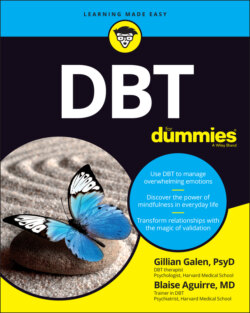Читать книгу DBT For Dummies - Gillian Galen - Страница 83
Secondary emotions
ОглавлениеUnderstanding your emotions would be a little easier if not for secondary emotions. Secondary emotions are where you may get tripped up. These emotions are most commonly the result of thinking about your primary emotion. Your beliefs, judgments, and attitudes about emotions move you into secondary emotions — for example, getting sad and then thinking that sadness is weakness and so getting angry. Sadness is the primary emotion, the one that makes sense in the context of what you just experienced, and anger is the secondary emotion resulting from your beliefs and judgments about sadness.
A primary emotion lasts an average of 90 seconds if we don’t apply a chain of thinking that turns it into a secondary emotion. The problem with secondary emotions is they can last a long time — hours, days, weeks, months. You can get stuck in secondary emotions, and those emotions tend to perpetuate themselves with ease. Feeling miserable is a great example of getting stuck in a mix of secondary emotions. One tricky thing about secondary emotions is that a primary emotion can, in fact, also be a secondary emotion. If your beliefs, judgments, and attitudes about sadness lead you to feel more sadness, then sadness is also secondary. Self-invalidation and invalidation from others is an easy way to land in a secondary emotional experience. So, if you experience an emotion lasting more than 90 seconds (before something else prompts it), then you’re likely inadvertently making sadness stick around longer than it needs to. It’s actually a great clue! This is why it’s so critical to learn to pay attention and be able to identify, label, understand, and validate your emotions.
